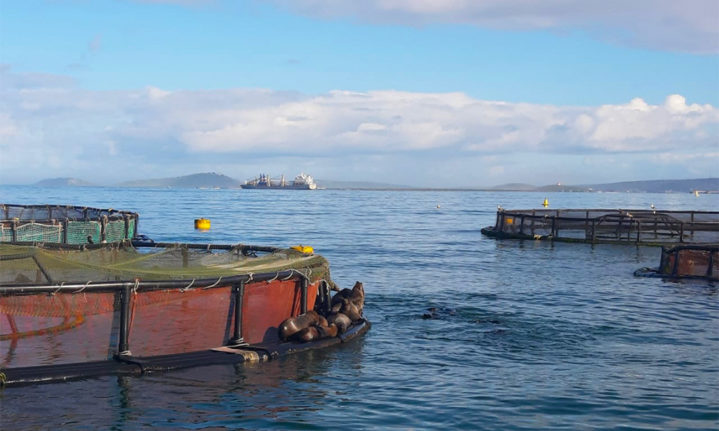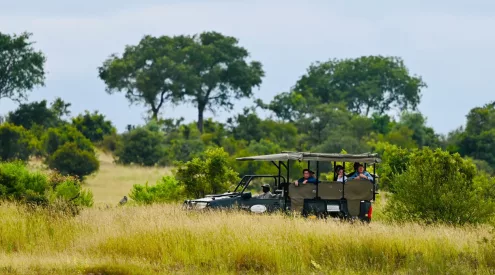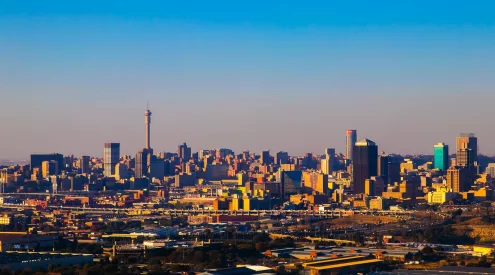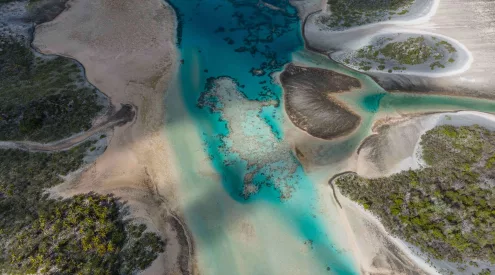The blue waters of Langebaan Lagoon provide a nursery for young fish, feeding grounds for migrant and local birds and a playground for humans. Could aquaculture in Saldanha Bay threaten more lives and livelihoods than it aids?
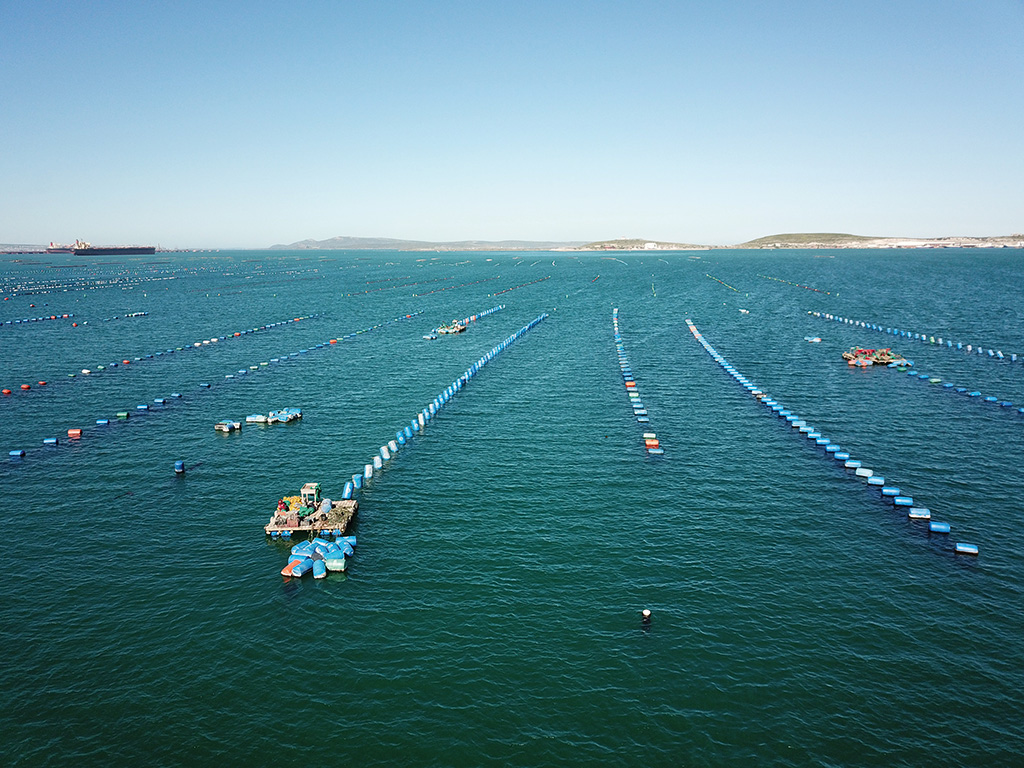
A web of mussel-farm long lines stretches across Saldanha Bay. Image credit: Supplied
For 30 years, kitesurfers, windsurfers and dinghies raced from Langebaan’s Main Beach to Saldanha’s
Dial Rock in the annual Langebaan Downwind Dash. But in 2019, the event was cancelled. The Dash’s Facebook page cited a lack of sponsorship, but owner of kitesurfing school Kite Lab, Alan Steele,
also blames the expanding aquaculture infrastructure in Saldanha Bay. ‘There’s a spiderweb of buoys
and nets and cages drifting all over the place. You can’t put people out there.’
The Saldanha Aquaculture Development Zone (ADZ), set to grow to 884 hectares once fully operational, is opposed by Save Langebaan Lagoon (SLL), which believes the industry spells the beginning of the end for tourism. The mussel farmers’ rafts and ropes are one thing, but finfish farming – raising fish in crowded captivity in ocean water – has ignited worries about water quality.
There are currently eight finfish cages in Saldanha’s Big Bay – a pilot project by Molapong Aquaculture. They contain ocean trout, a carnivorous alien fish, and the plan is to expand to salmon. They are fed on food made from smaller species hoovered up somewhere in the world’s oceans. The cages filled with fish are anchored and rotated, disturbing the ocean floor.
In all finfish farming globally, faecal waste, plus waste food, sinks to the seabed. Basically, it’s factory farming, so any pests or diseases can spread like wildfire. Treatment, with antibiotics or pesticides,
filters into open water. Cages are also treated with chemical anti-foulant to stop stuff growing on them.
In Saldanha, it’s been said that traditional pesticides and antibiotics won’t be used and anti-fouling is applied on land, but Molapong and the DEFF didn’t reply to queries asking for clarity.
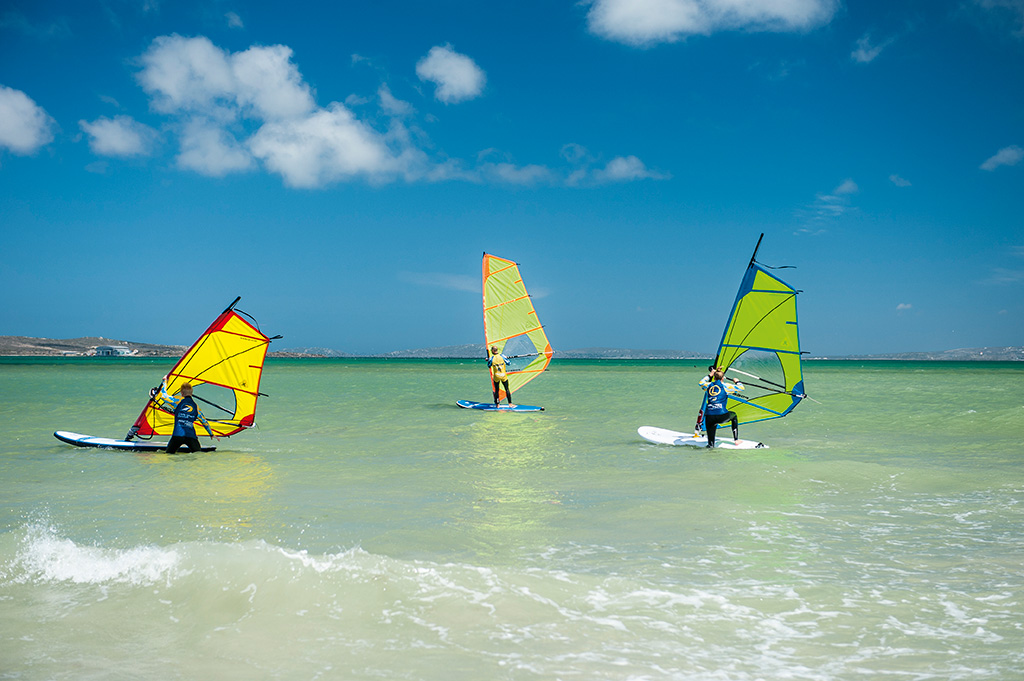
Image credit: Justin Fox
SLL is not anti-mussel farming, although there are worries about the scale. Finfish are different,
says SLL secretary Inge Frost. ‘Our lifestyle revolves around a healthy lagoon and the water not being contaminated or polluted – about 35% of the town’s industry relies on tourism. The sailing schools alone brought in R51 million two years ago.’
Michael Clemitson, a fellow concerned resident and former agriculture engineer, is adamant that should finfish farming go ahead, in time, ‘Langebaan Lagoon will die.’
The neck of the lagoon is two narrowish gaps, either side of Schaapen Island. No one knows if pollutants from the ADZ will be washed into the lagoon – sediments alone are problematic, but faecal waste has other effects. Michael explains: ‘When excrement decomposes, it absorbs oxygen and releases nitrogen and phosphorus. You get a dead zone underneath farming cages. It’s fact. Dead matter gradually builds up, and each cage distributes faeces in a wide radius. What is doubtless is we’re going to have water that has low oxygen and high nitrogen drifting into Langebaan Lagoon, a fish nursery and protected Ramsar birding site.
The water will deteriorate, which will mean more growth of algae and reeds and less oxygen for the fish breeding there. That means there will be fewer birds.’
BirdLife SA’s concerns about aquaculture in sensitive marine habitats centres around disturbance, pollution, possible entanglement and using species such as sardines and anchovies as fish feed – putting more pressure on already depleted wild supplies. Escapee carnivorous fish, too, are unwelcome. BirdLife is ‘opposed to open-net cage aquaculture … where potential negative impacts on the marine environment exist’.
Christo van Wyk, operational manager of the Saldanha Bay Water Quality Forum Trust, an NGO, says that there is ‘scientific uncertainty’ about the movement of water between Saldanha’s Big Bay and Langebaan Lagoon. The water column in Big Bay is known to ‘roll over’ at times, which could result in faeces welling up in shallower waters and washing into the lagoon.

The fish-farming cages may be attracting seals (bottom), and watersports fans are worried that sharks will follow the seals into Langebaan Lagoon. Image credit: Supplied
However, Christo believes an adequate monitoring system is in place – which is also why the ADZ is proceeding in phases. Implementation will be the challenge. ‘We must watch them. There is the issue of future capacity. And monitoring costs money…’
Waste feed under and around cages also attracts wild fish. (‘It’s like a fast-food takeaway,’ says Michael.) ‘We’ve seen a huge increase in the seal population in the last 12 to 18 months,’ says Christo. ‘Are these fish farms now the trigger for seals to come in? Or is it that the pelagic fish have moved off and the seals are looking for food?
And what will those seals trigger? Will they bring in sharks? That will impact on recreation,
like the kitesurfing. It’s an unknown. I understand people’s worries.’ SLL has photographs of seals
sitting on – and in one instance, swimming in – Molapong’s finfish cages.
Finfish farming is also a major ethical problem. Michael says it takes 2,4kg of feed to raise 1kg of farmed fish. According to a 2019 article in Issues in Science and Technology, ‘Around one-third of the global fish catch is turned into feed for other animals, roughly half of which goes to aquaculture. Many fishmeal fisheries are subject to overfishing and are declining.’
In November, Saldanha Steel announced it was closing – 1 000 jobs may go. The need for jobs is paramount in the area. Mussel farmer Nolan Adams employs 11 people in Saldanha, and 120 others work in bivalve processing in Velddrif, supplying the local market and exporting to the UAE.
Nolan believes that stringent export regulations will help prevent pollution. He is keen to expand and is awaiting water-quality checks due to take place in February 2021, which will establish if the carrying capacity is sustainable. Mussels, which absorb toxins, are very susceptible to changes in water quality. Nico Prins of the SA Bivalve Shellfish Farmers Association also has confidence in the slow roll-out of the ADZ and extensive monitoring.
As ecosystems are entwined, however, it’s hard to look at aquaculture in isolation. ‘The bay is under tremendous pressure,’ says Christo. The 2019 State of the Bay report (sbwqft.org.za) tells of invasive species, plummeting numbers of juvenile fish and island birds, sewage risks, overfishing, heavy-metal contamination and increasing development and disturbance.
A large ADZ will only add to stress on the system. And tourism jobs count too.
How to help
• Save Langebaan Lagoon is raising funds to fight the Saldanha ADZ expansion in the High Court. Lawyers are expensive. SLL’s banking details are on the website: savelangebaanlagoon.co.za
– SLL is also crowd-funding – search for it on backabuddy.co.za.
• Donate to the Aquaculture Stewardship Council’s efforts to promote responsible aquaculture.
asc-aqua.org
Text: Janine Stephen











